|
reprinted
from
Adventures
In
Owning
A
Tennessee
Walking
Horse |
|
POINTS OF THE HORSE ANATOMY |
Tennessee Walking Horses
generally range from 14.3 to 17 hands and weigh 900 to 1200
pounds. The modern Tennessee Walking Horse possesses a dry, pretty head
with small, well placed ears. The horse has a long sloping
shoulder, a long sloping hip, a fairly short back and short,
strong coupling. The bottom line is longer than the top line,
allowing for a long stride.
|
|
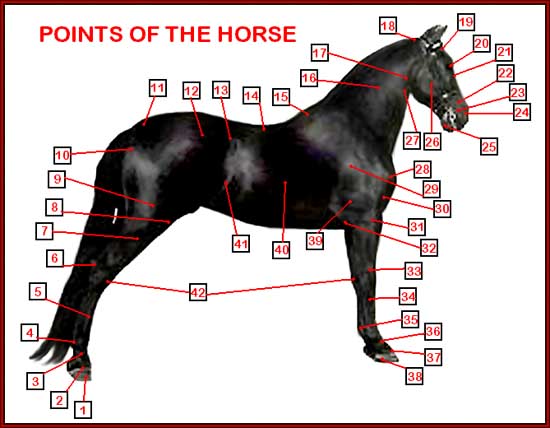 |
|
|
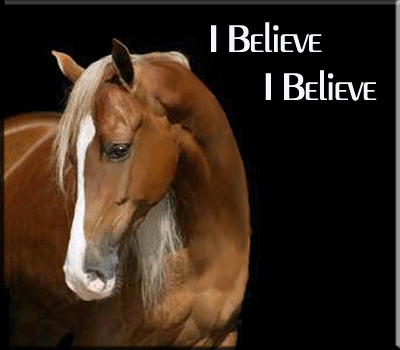 |
The Tennessee Walking Horse - Head
The Tennessee Walking Horse's head should be in proportion to the
rest of the animal's body. The head and throatlatch should be
refined and clean-cut, with the facial bones exhibiting a
chiseled appearance. The eyes should show character, being of
good size and well placed, with good width between the eyes. They
should be clear and bright. The face should be straight, rather
than convex (Roman-nosed) or concave (dish-faced). The ears should
be well set, medium to small in size, and they should be carried
forward showing attentiveness. The muzzle should be small, with
large, sensitive nostrils. The upper and lower teeth should meet.
The jaw should show bone structure but should not show excessive
thickness.
|
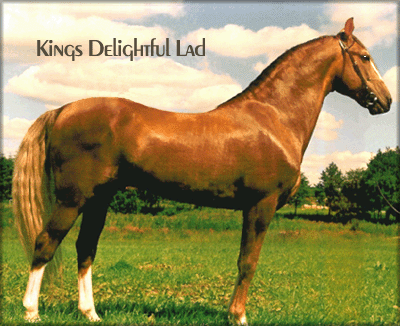 |
The Tennessee Walking Horse - Neck
The head should join the neck at approximately a
45 degree angle, with a distinct space between the jawbone and
neck. The neck should be medium to long in length, and the head
should be carried high. In the adult, the neck should be slightly
arched. The neck should be lean and muscled and blend smoothly
into the shoulders and withers.
|
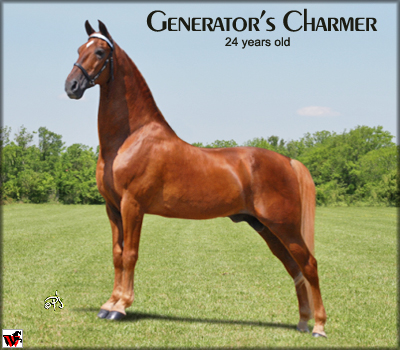 |
The Tennessee Walking Horse - Balance
A Tennessee Walking Horse should have a balanced appearance. Balance is the single most important characteristic in equine selection because it forms the basics for movement, length of stride and, ultimately, performance. Balance is determined by the skeletal structure. When judging, it is important to attempt to visualize and evaluate the skeleton of the horse underneath muscle and other tissues. Slope of shoulder is critical to balance. Slope of shoulder changes drastically when the angle of the shoulder is increased or decreased. Not only does the top-to-bottom line ratio of the neck change, but the ratio of length of back to length of underline also changes. It is ideal to have a short top line and a long underline. The balanced horse will also have legs that are approximately the same length as depth of heart.
|
|
Photo by Scruggs Photography |
The Tennessee Walking Horse - Shoulder
The shoulder should be long and slope forward at
an angle of 45 degrees from the withers to the point of the
shoulder. The shoulder should be smooth, yet well muscled. The
withers should be at least as high as the top of the rump.
In addition to overall balance, slope of shoulder influences
length of stride. Thus, the steeper the shoulder, the shorter the
stride. Angle of shoulder and angle of pastern serve to absorb
shock when the horse moves. Horses with long sloping shoulders
will be better able to disperse the damaging effects of
concussion, and their strides will have more freedom of movement
and style of action.
|
|
THE MUSCLES OF A HORSE |
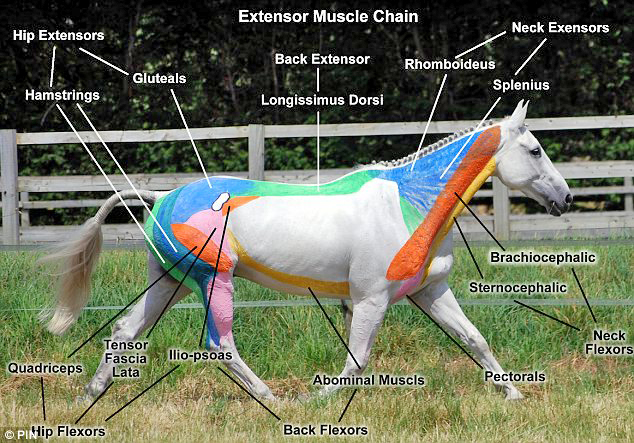 |
The Tennessee Walking Horse - Topline
The topline of the Tennessee Walking Horse
should be level, or slightly sloping to the hindquarters. The back
should be short to medium length, with a short, strong loin. The
croup should be long with good muscling and a well set tail. The
croup should slope moderately from the point of the hip bone to
the point of the buttock. The topline of the horse includes
the withers, back, loin or coupling and croup. As viewed from the
side, a properly balanced horse will be higher at the withers than
at the croup. When the withers are higher than the croup, the
hindquarters are positioned more under the body, which enhances
the athletic ability of the horse. Strength of topline, which
includes prominent withers, short, strong back and well-muscled
loin, has a positive influence on soundness and athletic ability.
The ideal withers should be sharp, prominent and well-defined. The
well-defined withers are important from the standpoint of holding
a saddle on the horse without excessive tightening of the front
cinch. Tennessee Walking Horses should have short, strong
backs relative to a long underline. The topline to underline ratio
(Figure 3) plays an important role in balance, length and type of
stride. Length of back is directly related to length and slope of
shoulder and top to bottom line neck ratio. The loin (coupling)
should be well-muscled and strong . The loin is the pivot point of
the horse's back and is the area between the last rib and the
croup. Short, muscular loins are needed to carry power from the
hind legs forward. The croup should be long and gently
sloping. This adds length to the stride as well as dimension and
muscling to the hindquarter. The flatter and more level the croup,
the more likely that horse will move with a vertical action behind
and less of a horizontal action. The horse with a steep croup will
move with the legs more collected under the body. The angle of the
croup will have a great influence on the position of the hock.
Moreover, these two factors together will dictate a collected,
balanced horizontal movement.
The Tennessee Walking Horse - Hindquarters
The hindquarters of the Tennessee Walking Horse should be of
moderate thickness and depth, well muscled when viewed from the
side and rear. The muscling should be evident inside and out on
the rear legs. The hock joint should be fairly wide and deep, with
the joint being clean. The cannon area should be vertical from the
hock to the pastern, with the pastern showing a 45 degree angle
with the ground.
|
SKELETON OF A HORSE
(but not a TWH. Both the femur and the humerus are longer in a TWH,
creating more pronounced angles to the hip and shoulder.) |
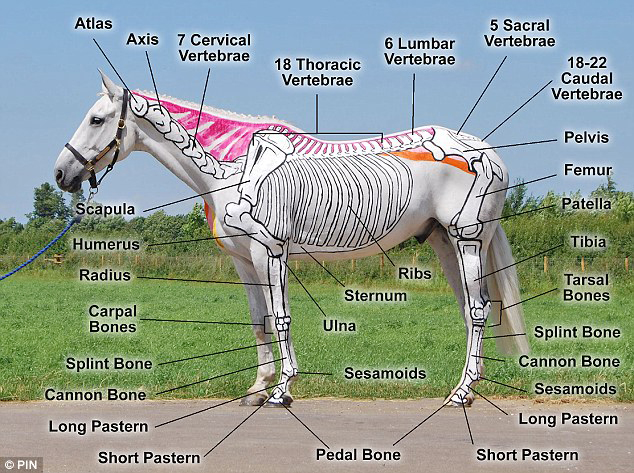 |
Conformation of the Tennessee Walking Horse is
directly related to skeletal structure. It includes the bones and
ligaments which bind the bones together to form joints. The
manner in which a horse moves is determined by the horse's
conformation and skeletal structure. The usefulness of Tennessee
Walking Horses depends on their ability to move and perform in an
appropriate manner. Structural correctness ultimately
determines the value and usefulness of a horse. Regardless of
whether the horse is a favorite at the Celebration or a youth's
pleasure mount, the length and angle of the bone structure,
combined with skeletal correctness play a critical role in the
usefulness of the athlete. An understanding of skeletal make-up
will assist in the evaluation of horse conformation.
|
|
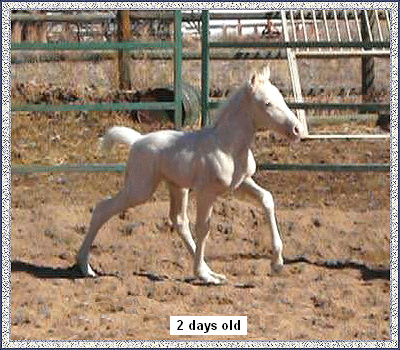 |
|
|